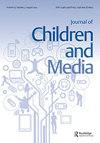Representations of LGBQ+ families in young children’s media
IF 2.1
3区 心理学
Q2 COMMUNICATION
引用次数: 0
Abstract
Representations of lesbian, gay, bisexual, and queer (LGBQ+) characters in children’s media have proliferated over the last five years (GLAAD Media Institute, 2019). In large part, this shift has occurred because attitudes toward LGBQ+ individuals have substantially improved among the general public, thus incentivizing content creators to diversify their representations (GLAAD Media Institute, 2020). Most LGBQ+ characters, however, have appeared in programs targeted to older children (i.e., ages 7 and older), with relatively few appearing in programs targeted to younger children (i.e., ages 3 to 6). This discrepancy likely stems from the fact that these programs typically depict ageappropriate romances among same-sex characters (e.g., crushes or dating). Although these stories allow older LGBQ+ children to see themselves represented on screen, they are less socially meaningful for younger children. It is possible, however, to include socially relevant LGBQ+ representations in media for young children by focusing on diverse families. Family diversity varies across dimensions of race, socioeconomic status, gender, and family structure (Fine et al., 2000). Here, we focus on diverse family structure, such as a child who has two fathers or a child who has a mother that remains single because she is aromantic. In this commentary, we consider the theoretical importance of LGBQ+ representations in young children’s media, review the current state of these representations, and provide recommendations for researchers and practitioners.LGBQ+家庭在儿童媒体中的表现
在过去五年中,女同性恋、男同性恋、双性恋和酷儿(LGBQ+)角色在儿童媒体中的表现激增(GLAAD媒体研究所,2019)。在很大程度上,这种转变的发生是因为公众对LGBQ+个人的态度有了实质性的改善,从而激励内容创作者使他们的表现多样化(GLAAD媒体研究所,2020)。然而,大多数LGBQ+角色都出现在针对年龄较大儿童(即7岁及以上)的节目中,而针对年龄较小儿童(即3至6岁)的节目则相对较少。这种差异可能源于这样一个事实,即这些节目通常描述同性角色之间的适龄恋情(例如,迷恋或约会)。尽管这些故事让年龄较大的LGBQ+儿童能够在屏幕上看到自己的形象,但对年龄较小的儿童来说,它们的社会意义较小。然而,通过关注不同的家庭,可以在媒体上为幼儿提供与社会相关的LGBQ+代表。家庭多样性因种族、社会经济地位、性别和家庭结构而异(Fine等人,2000年)。在这里,我们关注的是不同的家庭结构,比如一个有两个父亲的孩子,或者一个有一个母亲因为aromantic而保持单身的孩子。在这篇评论中,我们考虑了LGBQ+表征在幼儿媒体中的理论重要性,回顾了这些表征的现状,并为研究人员和从业者提供了建议。
本文章由计算机程序翻译,如有差异,请以英文原文为准。
求助全文
约1分钟内获得全文
求助全文

 求助内容:
求助内容: 应助结果提醒方式:
应助结果提醒方式:


